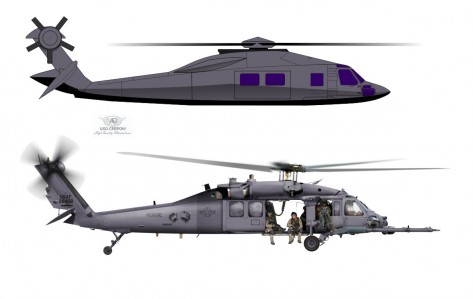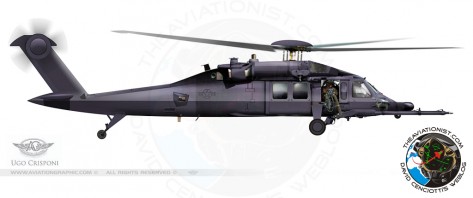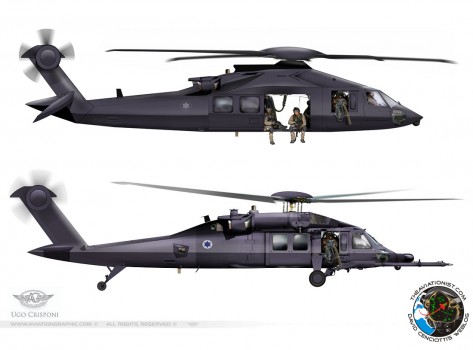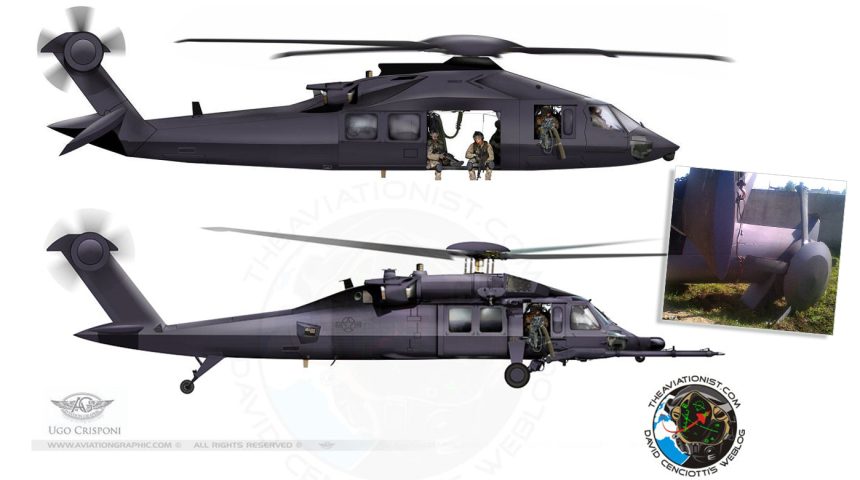Few hours after the raid that exposed the existence of a Stealth Black Hawk, The Aviationist published a sketch of how it could look like. Although it was a fruit of imagination, it inspired many of the subsequent portrayals of the secretive chopper.
As the first images of the remains of one of the helicopters used by the U.S. Navy SEALs in the raid that killed Osama Bin Laden, started to spread through the social media on May 2, 2011, aviation experts and enthusiasts around the world immediately noticed something pretty weird: those parts, didn’t seem to belong to any known type of chopper. Few hours later, on May 3, 2011, this Author was probably the world’s first to write that the helicopter that had crashed in Pakistan had some stealthy features.
Indeed, the tail rotor had an unusual cover that could be anything from an armor plate to a noise reduction cover sheltering the motion-control technology used to input low-frequency variations of rotor blade pitch-angle, as tested by NASA; the blades were flatter, and not wing-shaped, whereas the paint job was extremely similar to the kind of anti-radar paint and Radar-Absorbing Material coating used by the most modern stealth fighters: nothing common to either Black Hawks, Chinooks or Apaches helicopters.
According to the few official statements released in the aftermath of the raid, the helicopter did not suffer any failure but skittered around uncontrollably in the heat-thinned air forcing the pilot to crash-land. As it did, the tail and rotor hit on one of the compound’s 12-foot walls.
Whatever the cause of the crash (human error while flying with NVGs, wake turbulence generated by the other chopper or “recirculation”), the SEALs reportedly tried to destroy the crashed helicopter to hide its technology, but the tail section survived the attempt to blow it up because it had fallen outside of the compound giving the world the opportunity to have a glance at an advanced technology developed since the Cold War era, when the U.S. ran a series of black programs aimed at making the Navy Special teams penetration of Soviet naval installation and harbors easier.
Although it is extremely difficult to say whether the one involved in Operation Neptune’s Spear (also known as Operation Geronimo by the codeword used to designate Bin Laden) was a heavily modified existing type or a brand new type of helicopter, the images prove two things: first, that the so-called black projects, secret projects involving new technologies, are not only rumors or speculations; second, Osama Bin Laden was such an important target to justify the use of an extra-secret technology inside an “enemy” territory.
The possible shape
This Author begun studying the possible shape of what the so-called “Stealth Black Hawk” or “Silent Hawk”, immediately after the first pictures of the helicopter’s tail section appeared online. With the help of Ugo Crisponi, an artist at AviationGraphic.com, I imagined what the full stealthy chopper would have looked like after applying the tail section and rotor revealed by the photographs, along with imaginary engine shields, rotor covers, an extra main rotor blade (to slow down the rotor speed making blades quieter) and some imagination.

Although it was based on a few surviving chunk of metal and fantasy (hence fairly inaccurate and resembling an S-76 more than an MH-60), the initial sketch went viral. I was interviewed by media all around the world and the sketch itself was used by news agencies, newspapers, TV broadcasters, documentaries, as if it was the real portrayal of the still secret Stealth Black Hawk. Model kits and diecast helicopters were also based on that concept image. If you Google “Stealth Black Hawk” and search by images, you’ll find many occurrences of the first and subsequent reviews of the rendering, as well as many other artist impressions influenced by them.
While fictional, it’s worth noticing that the various reviews of the original rendering appear to have something in common with an in-depth study by the Sikorsky Aircraft Division, dated 1978. Indeed, as once again The Aviationist first discovered and reported on May 17, 2011, a document titled: “STRUCTURAL CONCEPTS AND AERODYNAMIC ANALYSIS FOR LOW RADAR CROSS SECTION (LRCS) FUSELAGE CONFIGURATIONS”, issued by Sikorsky Aircraft Division for the US Army Research and Technology Laboratories in 1978 provides tsome details about a project for a Low Observability UH-60.
Even though the fuselage concepts for low radar cross section aircraft configurations were designed at the end of the ’70s, the first attempts to give the UH-60 some stealthy capabilities are still useful to imagine a few modifications to the “classic” Black Hawk profile that might have made their way into the final Stealth Black Hawk.
Three LRCS fuselage configuration were developed by the Applied Technology Laboratory, both based on tail surfaces and main rotor pylon fairing of the baseline UH-60A.
The first configuration slightly altered the baseline fuselage forward of the mid-cabin section (the cockpit) producing a modified nose and a consequent slightly increased overall length.
The second configuration changed the fuselage shape along the lines of a truncated triangular prism with an increased overall length, width and height, a narrower cockpit space, and a vertical climb rate at 15 percent of the baseline UH-60A that did not meet the air transportability requirements of the baseline Black Hawk.
The third extended canted flat side shaping throughout the fuselage. The narrow cockpit caused the pilot and copilot seats to be spaced closer to each other, while the slope of the windshield was believed to cause problems of visibility for the flight crew.
The document did not identify a specific LRCS configuration to be used to get a radar-evading Black Hawk but the structural concepts developed for the study and aerodynamic analysis suggested a shape reminding more that of an F-117 than that of a more modern stealth, like the F-22 or F-35.
The Low Observability project may have not been the only study to inspire the shape of the Stealth Black Hawk flying in 2011. Some sources suggest the MH-X may have similarities with the YEH-60B SOTAS (Stand-Off Target Acquisition System) a particular Black Hawk version designed to detect moving targets on the battlefield and downlink the information to an Army ground station.
The only SOTAS built for the U.S. Army (flown in the early 1980s before the program was cancelled in favor of the E-8 JSTARS) had a retractable main gear whose shape could have been used on the MH-X as well. Few more upgrades may have been based on past prototypes, as the ACAP, the Army’s Advanced Composite Airframe Programme, whose goal was the development of an all-composite helicopter fuselage lighter and less costly to build than the predominantly metal airframes in general use.
Other upgrades were probably embedded to reduce the overall Radar Cross Section: a flat windshield with a gold layer for electrical continuity, fairings to cover the push rods and main rotor hub, retractable IFR (In-Flight Refueling) probe, as well as IR suppressors.

In 2015, a book titled “Relentless Strike” by Sean Naylor provided further details about the history of the MH-X. According to Naylor, an award-winning defense journalist, the two helicopters that took part in the Osama Bin Laden raid were the first prototypes of a classified program whose aim was to make the original Black Hawks less visible to radars through a series of modifications that rendered the helicopters harder to control in certain conditions. Two test examples were built and tested in Area 51, Nevada, before the program was cancelled; once the need to infiltrate the Pakistani airspace emerged, the two almost-experimental airframes were chosen to bring the Special Forces to Abbottabad.

Interestingly, according to Naylor, the raid to kill Osama Bin Laden was not the last time the Stealth Black Hawk was used in combat: reinvigorated by the successful outcome of the operation in Pakistan, the “Night Stalkers” flew the MH-X to Syria where they took part in the failed raid to free captured American journalist James Foley and other captives from ISIS, on July 4, 2014.
Although it has never been confirmed, the presence of the MH-X derivatives in Syria was also rumored in the aftermath of a daring raid that killed ISIS high level operative Abu Sayyaf at Deir Ezzor, southeast of Raqqa, in eastern Syria, in the night between May 15 and 16.
Other theories
In 2012, in a report written for a global intelligence newsletter, F. Michael Maloof, a former Pentagon senior policy analyst, suggested that the Israeli Air Force was equipped with the same Stealth Black Hawk helicopter used by the U.S. Navy SEALs to kill Osama Bin Laden. According to Maloof, the secret radar-evading choppers had been used by the IAF to drop Iranian dissidents into Iran to gather intelligence on the Tehran’s nuclear program.
It was the first time someone reported about the Stealth Black Hawk in the hands of Israel. Even though this information has never been confirmed we can’t completely rule out the possibility that, alone or with the help of Washington, the Israeli are operating (or have operated for a certain period in the past) a modified, stealthy variant of the IAF Black Hawks (nicknamed “Yanshuf”, English for “Owl”).
Needless to say, we made a rendering of the Stealth Yahshuf too!










